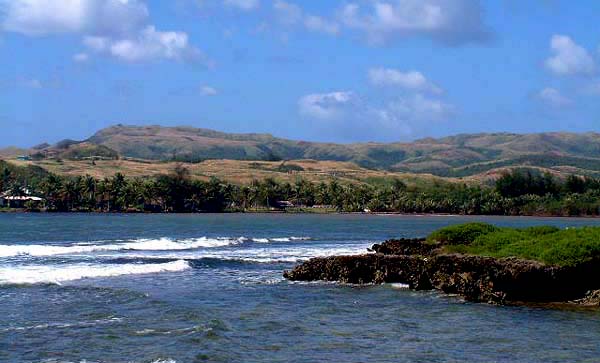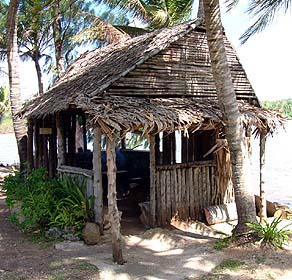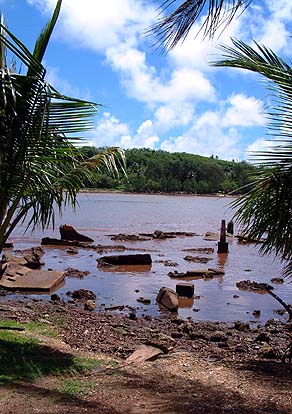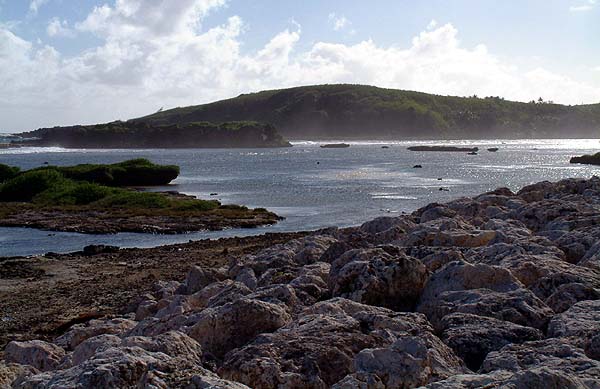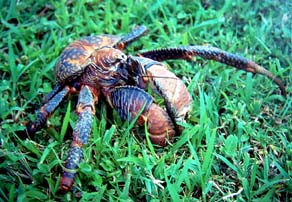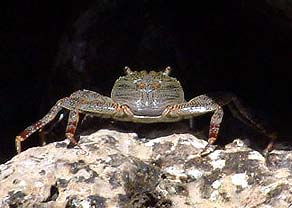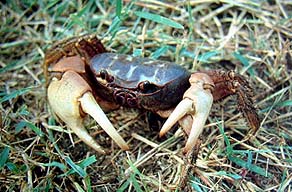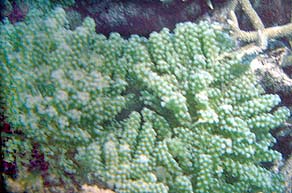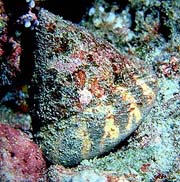 |
 |
 |
 |
||||
|
|
|
|
|
|
|
|
|
|
|
|||||||
|
|
|
|
Inarajan Bay, looking across at the village from Gådao's Cave.
|
|
|
The houses of Inarajan village have been situated alongside Inarajan bay for over 300 years, to avail its residents of fishing as well as upland farming. But this seaside location, beautiful most of the time, has its distinct drawbacks because of the passing of typhoons. Today there are few homes right next to the water.
|
||
|
|
||
|
“From what my father has told me," Sherey recalls, "the beach property was given to children or family members who have caused harm or shame to the family. You’re still family, but they’ll give you beach property, because it was not desirable. It was considered unwanted property. You can’t grow anything there. And our homes used to be thatch roofed, so when the typhoon comes in, it’s gone. "Everyone else will have the better property, which would be inland, far away from the beach, where you can farm. If you have houses away from the main beach area, it’s considered okay. "Nowadays, beach property is sought after. That’s the prime land these days, and a lot of people say, 'Okay, beach property, there’s a lot we can do with it.' But before, if you had beach property, people would react like, 'Oh, what did you do?'”
|
|
|
|
“There were houses in here, small houses. Huts, something like this,” Tan Floren says, pointing to the woven and thatched structures of Gef Pa’go. “I think, about one row in there, and this another one. But see, they’re all gone, they moved up to Malojloj. And this in here," she points into the water just off Gef Pa'go, "see there’s still that cement there? That was the bathroom. Imagine! It’s still there, and there’s another one on the other side. Those were two bathrooms." Therese adds, “There used to be a pier all the way out this way. There are still pillars, concrete foundations out there. According to my father, those used to be outhouses. In Merizo,they say the same thing. There was a pier going out, and there were cubicles on the pier. So if you needed to relieve yourself, you went out there and you did your stuff, and I guess everything went into the water. I hope they didn’t go fishing at that time! That’s really nasty. I think I’m glad I wasn’t born at that time. I don’t think I would want to go into the water or eat anything from the water!"
|
|
|
|
|
|
|
The danger from storm surge associated with typhoons has left its mark on the landscape. Joe points to the bank of large rocks that now protect the stretch of coast between Inarajan pools and Agfåyan Bay: “These were recently placed here at the cry of the people from Inarajan, because in the last typhoon, waves came in here and came all the way up to the cemetery, and started to erode the cemetery to the point of pulling out the coffins from the cemetery, into the waters. So the government came in and intervened—both federal and local government came in—and so now you have something which hopefully would stop the waves.”
|
||
|
|
||
|
But the seashore is also an area for gathering
important foods. Bill explains, “There’s the crab called
the ayuyu, the coconut crab. You don’t find it in the village.
That’s in a different area, below Malojloj, an area called Asiga.
That whole area down below the cliff is called Asiga. Somebody was trying
to buy that property and develop hotels and resort areas, I don’t
know what, but it didn’t happen. Anyway, that’s where you
find the coconut crabs. Somehow they live in rocky areas where they
can get in and stay in there. It’s called ayuyu—in
fact, that’s the last name of some people in Saipan.
|
|
|
|
“The reason it’s called coconut crab is that to hunt for it, you will need to cut a coconut, chop off a certain area of the coconut — you don’t open up the whole thing, but you just chop a certain area, remove the husk, and then remove the shell so that part of the coconut is showing. And that’s where you catch the crab. They will just stay there. I can just grab them, on the top, and hold them. The bigger it is, the better you can control it. They can’t get at you.”
|
|
“Then there’s the land crab, it’s called panglao tano’. There is also pånglao tasi. Tano’ is land, tasi is sea, so we have those two kinds of crabs that you normally catch. Tano’ particularly live in the land. Gosh, they come out in the evenings, but you have to wait until a certain time--it’s called gualåfon, when the moon is full. You just catch the pånglao tano’ by hand. They’re fast, so that’s another responsibility of being a male—you need to learn how to catch these crabs. "Then you steam them, or cook them with coconut milk. When I was growing up, coconut crab was something that you normally cooked. The land crab, or the one from the sea, or the coconut crab, this was something that you normally would have for dinner."
|
|
|
|
|
|
“Sea grapes too, it’s called addo’. The green one. It grows just by the reef area. According to my parents, if you actually harvested them near the land, it was not as good as the one by the reef. I don’t know what makes it better but I never liked it. " I never developed a great affinity for that. I never really liked fish. I guess that was the reason why."
|
|
|
Alileng, the trochus
or top shell.
|
“Also there is the shellfish alileng, the trochus or top shell. Oh man it’s good for kélaguen. Kélaguen is something normally you have at parties: kélaguen uhang, shrimp kélaguen, for example. It’s a mixture of lemon, salt and pepper, and the meat. You do kélaguen alileng from that shellfish. You can also kélaguen chicken and fish and all that kind of thing.”
|
|
|
|
|
We will hear about fishing soon, but first let us draw closer to the beach.
|
||
|
|
||
|
|
|
|
|
|

|
| Inarajan Home | Map Library | Site Map | Pacific Worlds Home |
|
|
|
|
|
|
|
|||
| Copyright 2003 Pacific Worlds & Associates • Usage Policy • Webmaster |
|||
